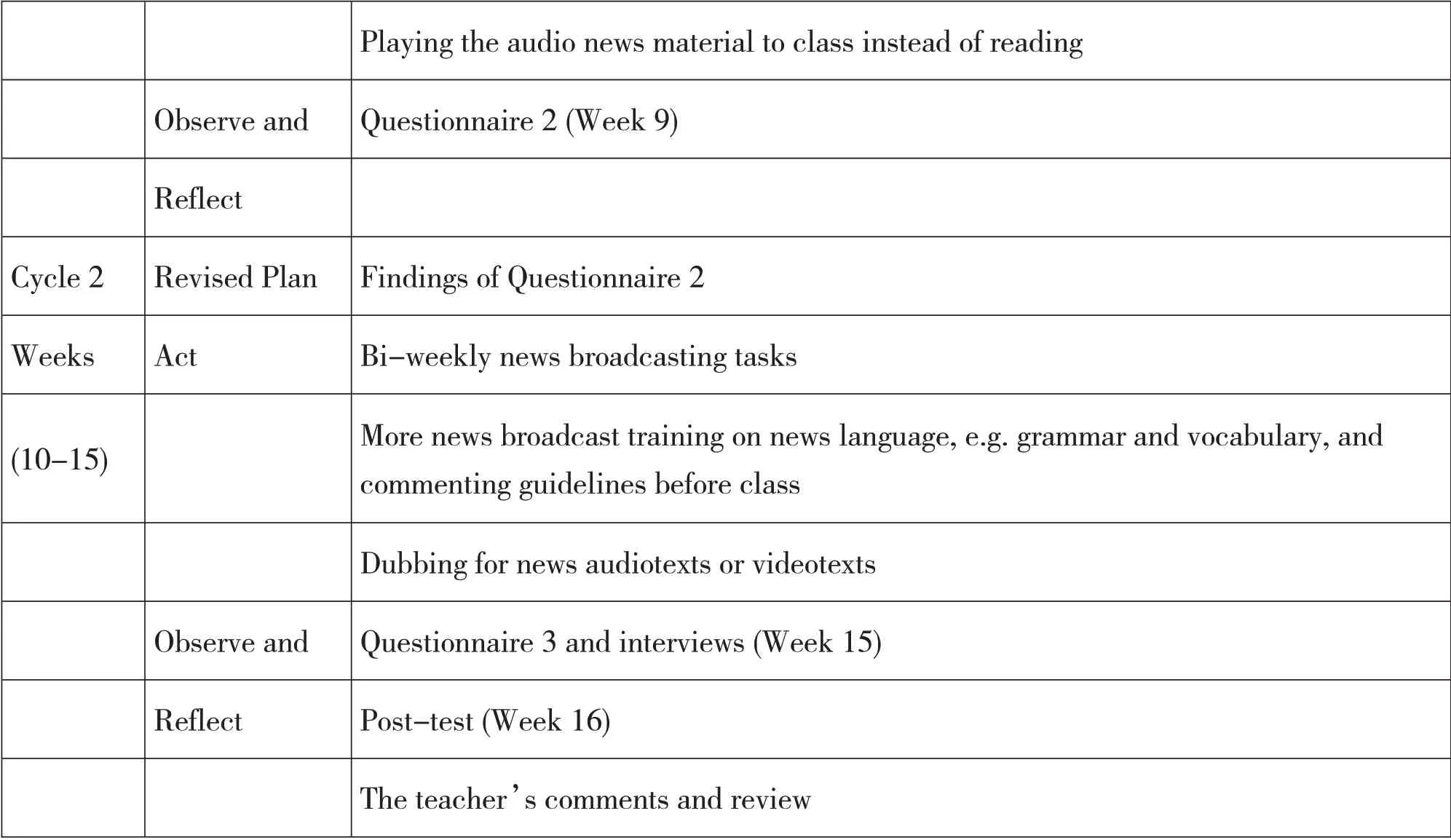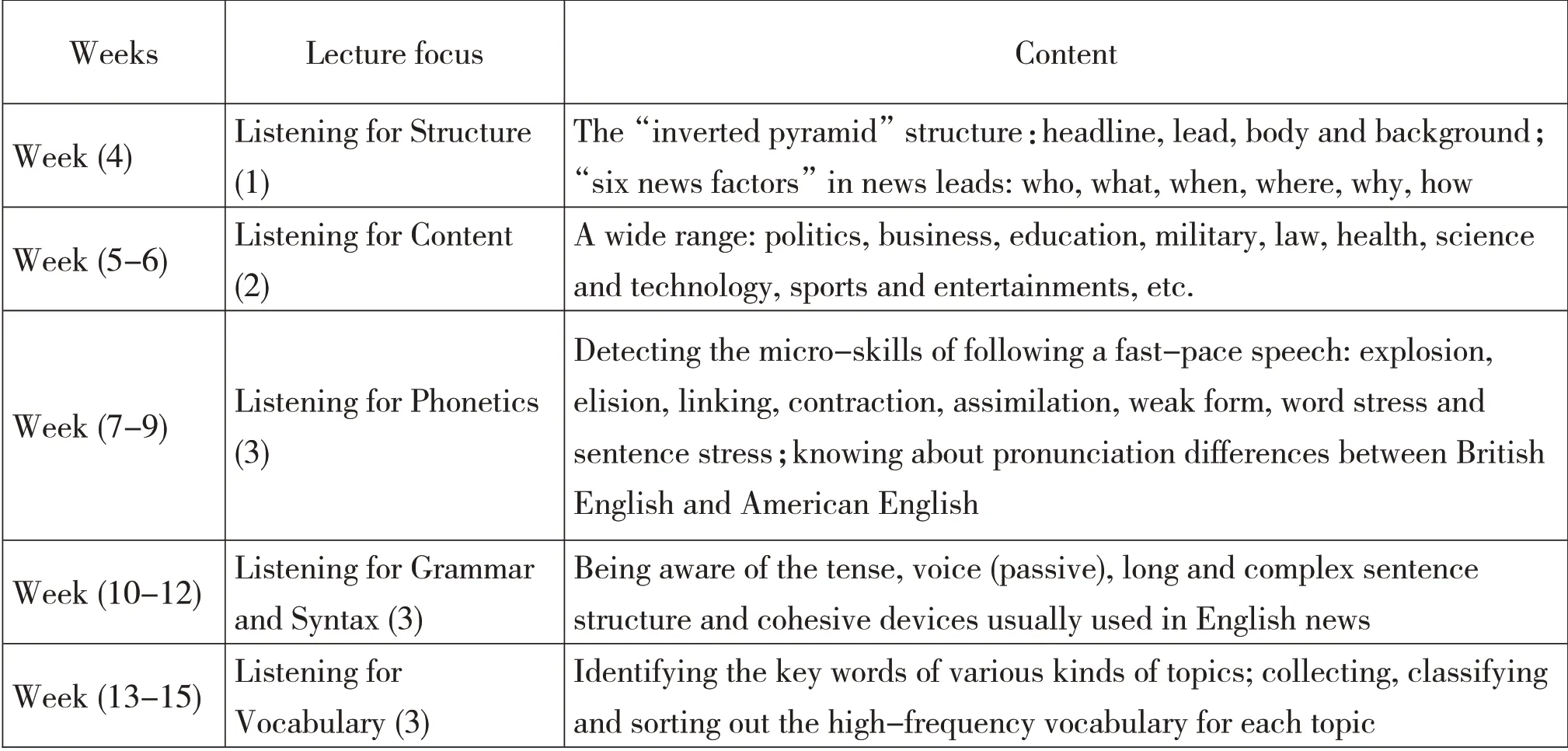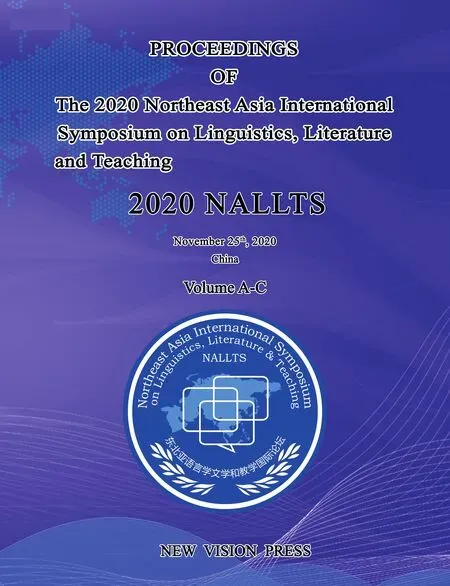An Action Research on Blended Learning through News Broadcasts in EFL Listening Context
2021-01-11
Xinjiang University,Xinjiang,China Email:1492818555@qq.com
[Abstract]This study has taken an action research approach to track the process of EFL students’English learning using news broadcasts.The author describes an action research project conducted with 32 second-year students majoring in Humanities at a Chinese university.This project aims to enhance EFL students’interest and confidence,thus improving their listening competence in a blended-learning approach using news broadcasts.The analysis of multiple sources of data including questionnaires,interviews,two tests,classroom observations,and teacher reflections illustrates how using news broadcasts can be an effective pedagogical learning activity in EFL listening context.
[Keywords]action research;news broadcast;EFL listening context
Introduction
as the most‘natural’language skill,listening which is the only skill that does not have to be‘learned’in the L1,paradoxically is the most challenging to master in the L2.It is also a very difficult language skill for Chinese EFL learners,who are known for their test-taking strategies on several standardized tests.However,getting high scores on these tests does not equal the same English listening and speaking proficiency.Most of them feel frustrated with the listening requests of national college English tests(CET).And the unprepared students were panicked in 2016 when a large proportion of news listening tasks were introduced into these tests.Some students give up on the listening tasks in exams whilst some even lose interest and confidence in learning English.Teachers are now striving to understand how to foster students’listening and speaking competence to make EFL education more effective for academic purposes or employment requirements(Fan,2012).Developments in broadcast and multimedia technology have generated a readily available and vast supply of audiotexts and videotexts for use in EFL learning context.
Literature Review
L2 Listening
Successful listening is more difficult to measure and remains the least researched of all four language skills(Nation & Newton,2009).Among the relatively smaller amount of work done on L2 listening,different views have been voiced regarding bottom-up processing and top-down processing(Wang,2012).A number of researches have yielded mixed findings on who are better able to engage in which type to assist their comprehension of the aural input.Difficulties in L2 listening comprehension have given rise to one major strand of research reflecting a top-down approach in the past two decades,this being strategy-based instruction.Research on a strategy’s effect on listening comprehension is mixed(Graham,2011),but predominantly positive(Vandergrift & Tafaghodtari,2010).But some researchers(e.g.,Cross,2009)have cautiously pointed out the importance of catering for strategies involved in bottom-up processes.
L2 Listening learning through News
Berber(1997)held that enough exposure to TV and radio news helped students easily cope with the comprehension of such materials.Mackenzie(1997)highlighted the possibility of using news reports at all levels of EFL learning and rejected the assumption it would be of no benefit when being used at the lowest levels of EFL situations.Many empirical studies have revealed that EFL/ESL students gain positive feedback if being given opportunities to be around with authentic listening or speaking materials such as news broadcasts(Taher&Tam,2011;Chen,2019)
Blended leaning
Recently,the blended-learning model has been widely used in EFL teaching with blended online/offline programs.Goodyear(2015)addressed the integration of teaching and instruction methods in a“student-centered”learning setting.Many scholars(e.g.,Yang,2017)explored the blended teaching mode of college English from different perspectives.
Methodologically,previous research on news and EFL listening has adopted qualitative and quantitative research methods to investigate the impact of news broadcasts on the listening or speaking competence.Little research has taken an action research to track the process of EFL students’learning through news.To address the above problems,this action research study,drawing upon multiple sources of data including questionnaires,interviews,two tests,classroom observations,and teacher reflections,illustrates how the blended leaning approach through news enhance students’interest and confidence,thus improving their listening competence.
Methodology
Burns(2010,p.2)held that action research is‘a self-reflective,systematic and critical approach to enquiry’to‘identify problematic situations or issues that the participants consider worth looking into more deeply’and intervene deliberately based on systematically collected data‘in order to bring about changes and improvements in practice’.Action research typically consists of four broad phases:planning,action,observation,and reflection.This study involved two cycles of investigation and reflection in which the results of the first cycle influenced the second one.
Participants
The participants were 32 second-year university students majoring in Humanities.They were native Chinese speakers taking a required college English course(4 hours each week)at a Chinese university in the 16-week autumn semester of 2019.The teacher is an applied linguistics master with 22 years of EFL teaching experience.Throughout the action research,the teacher,was highly involved in making plans for the tasks,taking actions to intervene when problems arose,conducting observations based on collected data,and reflecting on the findings in each cycle.
In the first week of the semester,CET-4(June,2019)was used as a pre-test to exam students’English listening proficiency.A pre-study questionnaire was employed to investigate their backgrounds,their attitudes towards English listening learning and experience with news listening.Half of the students reported to be weak in English listening without knowing how to improve it,few spending more than 2 hours in practicing English listening each week after class and 83%of the students had seldom listened to English news and felt anxious when doing listening tests.None of them received training in news listening.Most of the them knew little about news features.
The Intervention
Firstly,the students formed into 6 groups and a class blog was set up via Qzone.One member from each group had a weekly task of news broadcasting during the first 10 minutes of each 2-hour lecture,with one group having 3 minutes for broadcasting and examining the students’listening comprehension.The news selected by each group member could not be longer than one minute and had to be from the previous 3 days.The teacher posted self-made micro video lectures about listening skills in English news in QQ group every week.One group member read the news and asked two questions about it in class and posted it after class.And students were asked to comment on the news through the blog platform using the words they learnt from the news.
Instruments
Three questionnaires were distributed to students in Weeks 3,9,and 15 respectively to identify the problems encountered in each cycle and to analyze their responses to the interventions.Both questions on a 5-point scale and open-ended questions were included in the questionnaires.The questionnaire was adapted from Zhang’s(2010)survey items on the Status Quo of teaching and learning in college English news listening.Since the study explored students’perceptions of the process of listening improvement,more items regarding students’attitudes toward news broadcast were added in the questionnaires.Interviews with 8 randomly selected students were conducted at the end of the semester to complement the data obtained from the questionnaires.The questions covered their attitudes to news listening and the changes after the training.Two CET-4 were used as the pre-test and post-test to exam students changes in listening proficiency.
A Pilot Study
Before the formal action research was conducted,a pilot study was carried out in the first 3 weeks to help students get used to news broadcasting and commenting.The first questionnaire was distributed to assess the students’attitudes toward the practice at the end of Week 3.The results indicated that the majority of the students showed interest in it though some problems still emerged in the process.First,finding a one-minute English news clip from the previous 3 days is not so easy and editing is time-consuming.Second,students felt puzzled on how to raise questions on the news with no experience in news broadcast;however,they expressed their willingness to receive related training.Third,most of the students hoped the news reporter could play audio news instead of reading it to avoid being affected by their accent or incorrect pronunciation.Bearing these problems in mind,the action research formally started in Week 4.A summary of the two cycles of research and the training modules are presented in Table 1 and Table 2.

Table 1.Two cycles of the action research process

Cycle 2 Weeks(10-15)Observe and Reflect Revised Plan Act Observe and Reflect Playing the audio news material to class instead of reading Questionnaire 2(Week 9)Findings of Questionnaire 2 Bi-weekly news broadcasting tasks More news broadcast training on news language,e.g.grammar and vocabulary,and commenting guidelines before class Dubbing for news audiotexts or videotexts Questionnaire 3 and interviews(Week 15)Post-test(Week 16)The teacher’s comments and review

Table 2.Micro lecture training modules on news broadcast
Data Analysis and Results
Cycle 1:Weeks 4-9
Plan and Act
On the basis of the findings in the pilot study,the original plan was slightly revised in Cycle1.First,the authentic listening material could be news from within a week with a length of a minute and a half so that the groups could have more choice for varied topics.Second,to address students’lack of English news knowledge,the teacher made a micro video lecture and posted it in the class blog each week for students to learn before class to train their listening skills of news through knowing about its main features from structure,content to phonics.Third,students played the audio instead of reading news to class and raised questions about it after the teacher’s modelling.
Observe and Reflect
To observe and reflect on the effects of the actions,students’responses to the intervention of Cycle 1 were collected through Questionnaire 2.The results showed that the students became more satisfied with the news broadcast practice after some changes had been made(M= 4.31,SD=0.716).The news in a week provided students with opportunities to find more topics they are interested in,from politics,science to sports and entertainments,etc.They felt much happier when choosing the news without the strict limitation of length.The training helped them get the topic from news lead more easily and follow the news with micro skills in pronunciation.Almost all the students favored listening to TV or radio news broadcast than students’report.Such problems as the frequency of task,the training and the form of broadcast still emerged from students’answers to the open-ended question“What suggestions do you have in the program?”
Cycle 2:Weeks 10-15
Revised Plan and Act
In Cycle 2,further changes were made based on the findings from Cycle 1.The first change was that weekly broadcast tasks were changed to bi-weekly tasks for each group,so students could have more time to listen to more news to compare and select.Secondly,in order to enhance the students’listening competence and motivation in English listening,the teacher provided detailed training on language use of English news and guidelines on commenting on news according to students’requests.More news broadcast forms were added to stimulate students’interests,e.g.dubbing for authentic audiotexts or videotexts or acting as a TV or radio news reporter.
Observe and Reflect
Questionnaire 3 was distributed to the students to investigate their attitudes toward the actions taken in Cycle 2.The results revealed that 79%of the students showed a strongly favorable attitude towards the practice of news broadcasting(M=3.91,SD=0.602).They felt less nervous while listening to English news and spent more time practicing English listening after class.Besides,75% of the students thought it helpful(M=3.61,SD=0.723)in improving news listening proficiency.They reported gaining in background knowledge,patterns of discourse,vocabulary,speech rates and syntactic structures,etc.to help predict the main idea of news.It’s known from the interviews that students had grown to think critically and know more about the world.
In Week16,CET-4(December,2019)was conducted as a post-test to exam students’listening proficiency.The data analysis of a Paired Samples Test averaging 4.752 showed significant difference(p=0.0181<.05)between the two tests.It is thus possible to interpret that incorporating news broadcasts in EFL listening context helped enhance students’listening proficiency.
Discussion and Conclusion
This action research project illustrates how the blended learning program can be effective learning activity in EFL listening context.It’s found that using news broadcasts as supplement in class with the teacher’s instruction did boost students’interest and confidence in learning English and strengthen their listening proficiency.
The project shows that readjustment is needed considering some contextual factors might damage the effectiveness of the teaching approach when using authentic aural and visual materials.For example,the length of materials can change accordingly to engage students’attention; the news can be from the previous week so that students can have more time to listen and select;the source of news report can be varied including both audio and video so as to attract students’interest;the forms of news broadcast can progress from students’reading to the class,playing radio or TV news to dubbing for them;the broadcast task can be bi-weekly so the students don’t feel it is too burdensome and so they can enjoy it and achieve a more satisfactory job.
Given the nature and complexity of news texts,learners might be better served by shifting the focus of instruction.The blended approach combines teacher-led live instruction,self-made micro lecture training modules reporting practice and peer interaction to develop effective listeners.In Cycle1,top-down approach strategy-based instruction was employed for training,e.g.leading students to knowing about English news features from structure,content to phonetics.Students’response echoes Renandya’s(2012)questioning on the effectiveness of a top-down strategy in enhancing weak listeners’comprehension competence.Rost(2002)pointed that a key factor in successful listening is the individual’s ability to integrate information gathered from the two processes.Cycle 2 focused on grammar and vocabulary with bottom-up strategy-based instruction to meet students’needs.One aspect worthy of consideration is that students’learning experience and attitudes towards a given activity may change in the process of the action research,measures should be taken to cater to students’needs and promote their motivation to join the activity.
In sum,the objectives for this action research were achieved in the sense that students at the end of the project were more motivated and engaged in news listening and English learning and held more positive attitudes towards news broadcast.They were more confident in coping with authentic listening resource and have improved in listening proficiency.The implementation of this blended-learning approach may be a key component in helping learners gain in competence.However,the limited number of participants and relatively short time of the action may weaken the evidence of the research.In addition,more investigations are needed to identify criteria for determining which news materials are appropriate for use in L2 classrooms.It is thus hoped that longitudinal studies can further examine better learning effects with research on videotext-based assessment.
Acknowledgments
The author is a teacher at College of Foreign Languages in Xinjiang University and also a part-time researcher at Xinjiang Center for Comparative Studies of Chinese and Foreign Cultures & Intercultural Communication Research.
The research is funded by College of Foreign Languages in Xinjiang University(WY20171202,WY20161208),Education Department of Xinjiang(XJGXWYJG2018JA01)and by Xinjiang Center for Comparative Studies of Chinese and Foreign Cultures&Intercultural Communi cation Research(010716C03).
杂志排行
Proceedings of Northeast Asia International Symposium on Linguistics,Literature and Teaching的其它文章
- Exploration of the SPOC-based Blended Teaching Model:Case Study of Business English Course
- Reducing Students’Foreign Language Speaking Anxiety Through Drama Performance
- Growth Mindset in Teaching
- A Study on Corpus Stylistics Assisted English and American Literature Teaching
- Promoting Architectural Values in Culturebound Scenery in Tourist Destinations
- A Data-driven Study on the Semantic Prosody of Near-Synonyms
